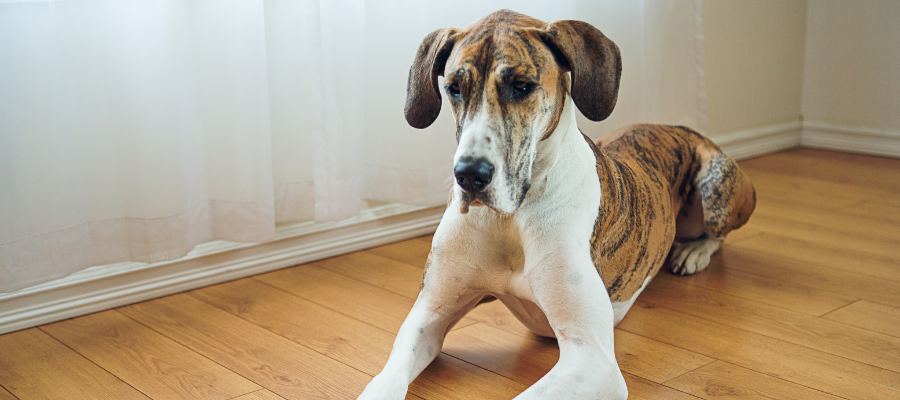It’s a common sight: you’re enjoying a cozy night in, your dog suddenly becomes frantic, whining and refusing to walk on your gleaming hardwood floors. You might even witness them skidding, their paws slipping and sliding, leaving you wondering, “Why is my dog scared of hardwood floors?” This phenomenon, known as floor aversion, is a puzzling behavior that can be both frustrating and worrisome for pet owners.

Image: www.flooringamerica.com
My own terrier mix, Max, used to exhibit this behavior in our previous apartment. The sleek hardwood floors, while beautiful, became a source of stress and anxiety for him. He’d scoot, cower, and even refuse to come inside when we got home after a walk. It was a head-scratcher, and I was determined to understand why this seemingly simple surface caused such a reaction.
Unveiling the Mystery: Potential Causes of Floor Aversion
The reasons behind a dog’s aversion to hardwood floors are multifaceted and can stem from a variety of factors. It’s essential to remember that dogs perceive the world differently than we do, and their sensitivity to texture, sound, and even temperature can play a significant role in their floor preferences.
Several potential causes contribute to floor aversion:
1. Slipperiness and Lack of Grip:
Hardwood floors, especially when polished, can be incredibly slippery for dogs’ paws. This lack of traction can lead to feelings of insecurity and fear of falling. Imagine trying to walk on a sheet of ice – that’s what a slippery floor can feel like to your dog.
2. Noisy Surfaces:
The sound of paws clicking on hardwood floors, especially when amplified by echoes in a larger room, can be startling and irritating to some dogs. This sound can be particularly distracting or stressful for dogs with sensitive hearing or those prone to anxiety.

Image: zackhardwoodflooring.com
3. Temperature Differences:
Hardwood floors tend to be colder than carpeted surfaces, especially during colder months. This temperature difference can be uncomfortable for dogs with sensitive paws or those with a fear of cold. They may avoid the floor to prevent discomfort or even potential paw injuries.
4. Previous Negative Experiences:
A dog’s fear of hardwood floors could be rooted in a past negative experience. Maybe they slipped and fell, got startled by sudden noises on the floor, or experienced pain from a nail trim on a hard surface. These memories can create a lasting aversion to hardwood floors.
5. Physical Pain or Discomfort:
Underlying medical conditions like arthritis, paw injuries, or other orthopedic issues can make walking on hard surfaces painful and uncomfortable for dogs. This discomfort can lead to avoidance behavior, as they seek relief from the pain.
Seeking Solutions: Helping Your Dog Overcoming Hardwood Floor Aversion
Fortunately, there are several strategies you can employ to help your dog overcome their floor aversion.
1. Gradual Desensitization and Positive Reinforcement:
Start by gradually introducing your dog to the hardwood floor. Begin with short periods of time, allowing them to explore the surface at their own pace. Provide treats and praise for any positive interaction, creating a positive association with the floor.
2. Non-Slip Surfaces:
Consider using non-slip mats or rugs strategically placed throughout your home, especially in high-traffic areas. These surfaces will provide better traction, giving your dog a sense of security and reducing the risk of slipping.
3. Minimize Noises and Distractions:
If noise is a factor, try to dampen the sounds of your dog’s paws on the floor. You can achieve this by using sound-absorbing rugs or even strategically placing furniture around the room to reduce echoes.
4. Warm Up the Floor:
During colder months, consider warming up the floor by placing a heating pad or rug underneath. This will provide a more comfortable walking surface, lessening the chill factor for your dog.
5. Professional Consultation:
If your dog’s floor aversion is severe or persists despite your efforts, consult with a veterinarian or certified animal behaviorist. They can rule out any underlying medical conditions and provide tailored guidance for addressing the behavior.
FAQs about Dog Floor Aversion
Q: What are some safe floor options for dogs?
Carpeted floors provide better traction and a softer surface for dogs’ paws. Consider using rubber mats or rugs with non-slip backing as alternatives for hardwood floors.
Q: Can I use dog socks or booties to help my dog walk on hardwood floors?
Dog socks or booties can offer additional protection and traction, but they must be well-fitted and comfortable for your dog to accept them. Start with short wear periods and observe your dog’s response.
Q: How long does it take for a dog to overcome floor aversion?
The time it takes for a dog to overcome their floor aversion varies depending on the severity of the issue and the individual dog’s temperament. It can be a gradual process that requires patience and consistency.
Dog Can’T Walk On Hardwood Floors
Conclusion
Understanding why your dog might be averse to hardwood floors is crucial for developing an effective solution. By addressing the root cause of the fear, whether it’s slipperiness, noise, discomfort, or past negative experiences, you can create a safer and more comfortable environment for your furry friend. Remember, patience, positive reinforcement, and maybe a few strategically placed rugs are all it takes to help your dog feel more at ease on those shiny hardwood floors.
Are you interested in learning more about navigating pet behavior challenges at home? Are you facing other unique challenges with your dog’s behavior that you’d like to discuss? Let us know in the comments below!

:max_bytes(150000):strip_icc()/OrangeGloEverydayHardwoodFloorCleaner22oz-5a95a4dd04d1cf0037cbd59c.jpeg?w=740&resize=740,414&ssl=1)




